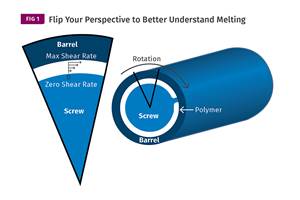Extrusion: Run Your Chevy Volt with Extruder Energy Savings—Part I
The electricity saved on a large extrusion line could power a number of Chevrolet Volts.
The electricity saved on a large extrusion line could power a number of Chevrolet Volts. An extruder uses a lot of electricity, and movements toward conservation and lean management require that we take a hard look at the energy efficiency of these machines. But to tackle electricity usage by the extruder you first have to understand just how an extruder uses it.
Electricity enters the extruder at the screw drive, the barrel heaters, and the controls. Energy leaves the extruder almost entirely as heat—in the polymer melt, barrel-cooling fluid, feed-throat cooling fluid, gearbox cooling fluid, or lost to the room air. By knowing where and how much heat is leaving the extruder you can go about minimizing the losses and thereby improving the energy efficiency. This is called constructing an “energy balance.”
The majority of the electricity used in single-screw extruders enters at the screw drive, and most of that goes into heating the polymer through shear and friction. Polymer transport, pressurization, and mixing consume a much smaller portion of “juice.” As the biggest electricity user, it’s important to see how effective the screw drive is in transferring energy to the product. That energy balance consists of matching the kilowatt-hours (kWh) used by the drive system to the heat transferred to the polymer. For amorphous polymers, that is simply the temperature increase in the polymer from the feed temperature to the melt temperature, as follows:
(Output) x (avg. specific heat) x (temperature rise) x (0.00029) = kWh
Crystalline polymers require an additional element called the heat of fusion, which is the energy required to convert a polymer from a solid to a liquid at the crystalline melting point. In other words, this is the energy required to break down the crystallinity of the polymer but results in no increase in temperature:
{[(Output) x (avg. specific heat) x (temperature rise)] + (heat of fusion)} x 0.00029 = kWh
Ignoring the heat of fusion can introduce serious errors when processing polymers like HDPE or nylon, where it can account for a major portion of the total power for heating and melting the resin.
To obtain total power usage—the electric input measurements to the extruder—requires you to connect a kilowatt-hour meter to the main distribution. The motor power is measured at the drive input leads. These are usually available for loan from your power company or can be purchased for about $2000. Sounds expensive, but on a number of large extruders this can pay for itself many times over in a single year. For instance, a change of 5% in energy efficiency on a 6-in. extruder running HDPE would provide an hourly savings of approximately 15 kWh. On a 24/7 basis this equals $10,000 to $15,000/yr in savings, depending on your electricity cost.
In addition to the drive conversion efficiency, a complete energy balance requires examination of the cooling of the barrel, feed throat, and gearbox. Finally, the losses from the barrel to the environment (room) have to be investigated. I have found many extruders can be improved as much as 20% when all aspects of the energy balance are considered. That translates into an annual savings of $40,000 to $60,000 per extruder.
Extruders with a good energy balance also typically run better, with a more uniform melt quality, because the flow of energy is consistent-i.e., intermittent heating/cooling cycles are eliminated.
About the Author
Jim Frankland is a mechanical engineer who has been involved in all types of extrusion processing for more than 40 years. He is now president of Frankland Plastics Consulting, LLC. Contact jim.frankland@comcast.net or (724) 651-9196.
Related Content
Single vs. Twin-Screw Extruders: Why Mixing is Different
There have been many attempts to provide twin-screw-like mixing in singles, but except at very limited outputs none have been adequate. The odds of future success are long due to the inherent differences in the equipment types.
Read MoreUnderstanding the Incumbent Resin Effect
When you are looking to replace an existing resin with a new one, in trials sometimes the “incumbent” resin will cause gels and other defects. Here’s what to look for.
Read MoreMaximize the Cooling Capacity of Your Extrusion Line
Maximizing output in extrusion requires a thorough understanding of not only the cooling requirements of the extruder but of the extrudate as well.
Read MoreUnderstanding Melting in Single-Screw Extruders
You can better visualize the melting process by “flipping” the observation point so the barrel appears to be turning clockwise around a stationary screw.
Read MoreRead Next
People 4.0 – How to Get Buy-In from Your Staff for Industry 4.0 Systems
Implementing a production monitoring system as the foundation of a ‘smart factory’ is about integrating people with new technology as much as it is about integrating machines and computers. Here are tips from a company that has gone through the process.
Read MoreFor PLASTICS' CEO Seaholm, NPE to Shine Light on Sustainability Successes
With advocacy, communication and sustainability as three main pillars, Seaholm leads a trade association to NPE that ‘is more active today than we have ever been.’
Read MoreLead the Conversation, Change the Conversation
Coverage of single-use plastics can be both misleading and demoralizing. Here are 10 tips for changing the perception of the plastics industry at your company and in your community.
Read More.jpg;width=70;height=70;mode=crop)












